This is Part III in a series designed to give readers a primer on the simple basics of some of the major periods of Western art in the hopes of giving you something to say on your next date to the museum and a deeper appreciation for art in general.
The Basics of Romantic Art
Time Period: 1800-1860
Background: The Industrial Revolution got into swing in the latter part of the 18th century, starting in England and spreading to France and America. This revolution brought with it a new market economy, based on new technology—machine tools and machine power instead of human tools and animal power. Villages exploded into urban centers and people moved to them from farms and the countryside to take jobs in newly opened factories. With little to no regulations in place, these jobs could be brutal. Men, women, and children worked 14 hour shifts; where they had once told time by the sun, now they could go weeks without seeing the light of day. Rapid growth produced cities that were dirty and crowded, the working poor often lived in squalor, and smokestacks darkened the air with soot.
While industrialization made consumer goods cheaper and increased the production of food, there were those who looked back on the past longingly, seeing it as a romantic period before people were commodified and nature blighted and destroyed.
At the same time, there was a growing reaction against the philosophy of the Enlightenment, which emphasized science, empirical evidence, and rational thought above all. Romantics challenged the idea that reason was the one path to truth, judging it inadequate in understanding the great mysteries of life. These mysteries could be uncovered with emotion, imagination, and intuition. Nature was especially celebrated as a classroom for self-discovery and spiritual learning, the place in which mysteries could be revealed to the mind of man. Romantics emphasized a life filled with deep feeling, spirituality, and free expression, seeing such virtues as a bulwark against the dehumanizing effects of industrialization. They also extolled the value of human beings, which they believed to have infinite, godlike potential.
Artists of the Romantic Period tried to capture these ideals in their work. They rejected the rationalism and rules-driven orderliness that characterized the Neoclassical style of the Enlightenment. Like Baroque artists, Romantic artists hoped to inspire an emotional response in those who viewed their art; but instead of seeking to inspire faith as their predecesors had, most sought to evoke a nostalgic yearning for rural, pastoral life, the stirrings of life’s mysteries, and a sense of the power and grandeur of nature. Art of this period also depicted the romantic ideal of nationalism, but for reasons of length, we will focus on landscapes in this post.
Examples of Romantic Art:
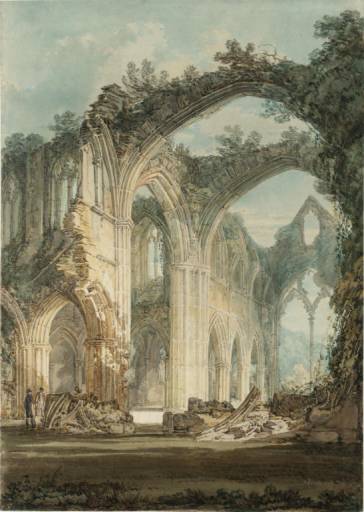
The Chancel and Crossing of Tintern Abbey, Looking Towards the East Window, by JMW Turner, 1794. Tintern Abbey was a monastery founded in 1131 and rebuilt in the 13th century. Abandoned in 1536, it was left to decay for two centuries. Artist Joseph Mallord William Turner paid two visits to the site, and it inspired him to paint this piece which juxtaposes the smallness of man alongside and wildness of nature, the unstoppable power of which has reclaimed this man-made edifice. The haunting abbey was a popular muse for many Romantics; it also inspired William Wordsworth’s famous poem “Lines Composed a Few Miles above Tintern Abbey.”
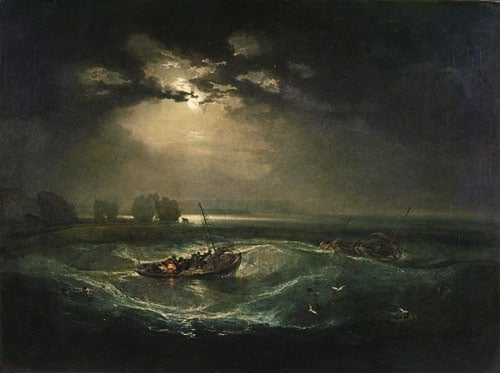
Fishermen at Sea, by JMW Turner, 1794. Turner was fascinated by the mood of nature, her ever changing effects. He was always sketching the clouds, the sky, and his natural surroundings. Turner was particularly fascinated with the power of the ocean and said that he had once asked to be lashed to the mast of a ship in order to “experience the drama” of a mighty storm at sea.
Romantics believed that God’s presence was embodied in nature and evidence of His existence. Turner saw light as a divine emanation and played with it in pictures to evoke that truth.
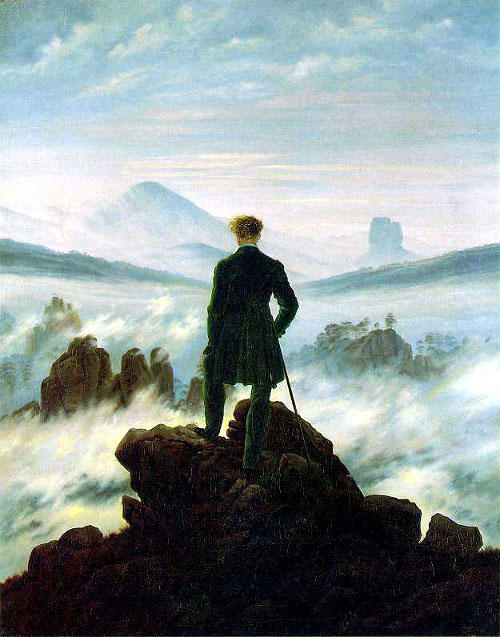
Wanderer Above the Sea of Fog, by Caspar David Friedrich, 1818. German artist Caspar David Friedrich was a quintessential Romantic artist, and this is a quintessential Romantic painting. It conveys both the infinite potential and possibilities of man and the awesome, mysterious grandeur of nature. The popular Romantic theme of the greatness of man contrasted with the sublimity and power of nature is on display. The man has climbed high and conquered much, only to see that there are infinite vistas still out there, shrouded in a fog that hides what lies beyond. Because of the way in which it speaks to the infinite potential of man, we decided to couple this painting with the poem “If” by Rudyard Kipling, and turn it into an Art of Manliness poster.
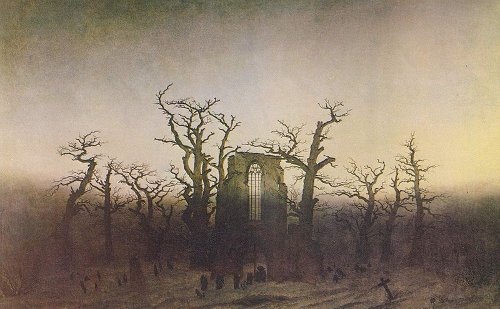
Abbey in an Oak Forest, by Caspar David Friedrich, 1810. Another captivating painting by Friedrich depicting the ruins of an abbey church which has become a graveyard. It captures several different Romantic elements at once. Like in Turner’s abbey piece, nature has reclaimed man’s handiwork. Friedrich loved to depict scenes in wintertime; the stark leafless trees and gray pall evoked that sense of melancholy, yearning, and mystery that Romantics so prized.
The Hudson River School
Inspired by the rugged, wild terrain of their (often adopted) nation and by the philosophy of Transcendentalism, American Romantic artists painted vivid, detailed, and sometimes idealized landscapes of the picturesque natural scenes by which they were surrounded. Painters of this style were said to be members of the so-called Hudson River School. The founder of this “school” was Thomas Cole, who captured the first landscapes of the Hudson River Valley when he took a steamboat into the area in 1825 and journeyed into the Catskill mountains. The second generation of these landscape artists ventured out of New York state to capture the sweeping landscapes of the West. What the Hudson River School artists had in common was a desire to convey both the sublimity and majesty of nature and the energy of exploration and discovery that pulsed throughout the new nation. The awe-inspiring vistas of the frontier were seen not just as manifestations of the hand of God upon the land, and also as a source of national pride; while Europe had its old ruins and architecture in which to glory, America had its natural monuments.

The Clove Catskills, by Thomas Cole, 1827. Thomas Cole, an Englishman used to more muted fall colors, was awestruck by the fall foliage he took in on his trip into the Catskill Mountains of New York.
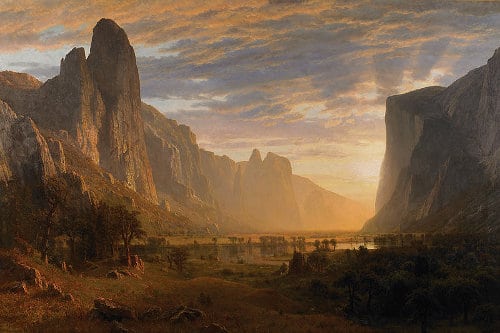
Looking Down Yosemite Valley, by Albert Bierstadt, 1865. German-American arist Albert Bierstadt left New York to capture the rugged beauty of the American West. As with other Hudson River Valley artists, he would sketch the areas he explored, as painting on site was impractical, and then turn the sketches into paintings upon returning home. The resulting landscapes were often a combination of different features seen in various locations, and the colors and especially the lighting were played with and intensified to heighten the awe-inducing effect of the scene.
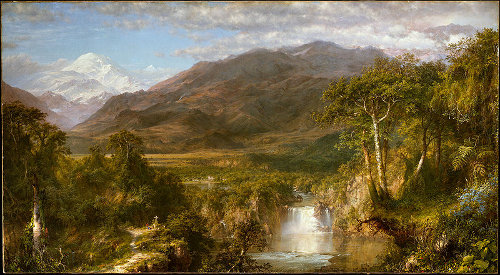
Heart of the Andes, Frederic Edwin Church, 1859. Church traveled outside the country to paint the landscapes of South America. Like many of the Hudson River School artists, Church painted this scene on a huge canvas, nearly five feet high and ten feet long. For those who had not the means to travel west or leave the country, viewing these paintings was a way to be transported to new places, and people would line up for a chance to pay admission to see them. When Heart of the Andes was unveiled, it was bordered by curtains to give the feel of looking out a window, and viewers were given opera glasses so that they might get a closer look at the painting’s details.
 Aurora Borealis, by Frederic Edwin Church, 1865. In a time before advanced photography, Romantic paintings provided ordinary people a chance to see natural phenomena they would never have an opportunity to witness themselves.
Aurora Borealis, by Frederic Edwin Church, 1865. In a time before advanced photography, Romantic paintings provided ordinary people a chance to see natural phenomena they would never have an opportunity to witness themselves.
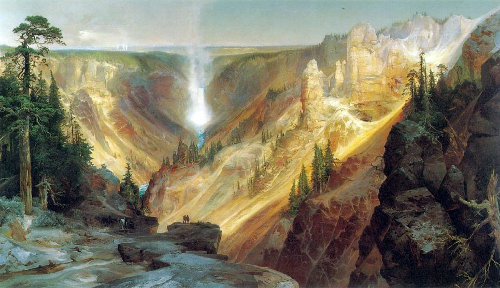 Grand Canyon of the Yellowstone, Thomas Moran, 1827. American landscape painters helped inspire the movement to preserve the most beautiful parts of the country’s wilderness and to create a national park system in order to do so. The sketches made by Thomas Moran when he accompanied a geological survey team into the then unknown Yellowstone area were later used to convince Congress to turn Yellowstone into a national park.
Grand Canyon of the Yellowstone, Thomas Moran, 1827. American landscape painters helped inspire the movement to preserve the most beautiful parts of the country’s wilderness and to create a national park system in order to do so. The sketches made by Thomas Moran when he accompanied a geological survey team into the then unknown Yellowstone area were later used to convince Congress to turn Yellowstone into a national park.
Two Series by Thomas Cole
To me, some of the most interesting paintings of the Romantic period are part of two series done by Thomas Cole: The Course of Empire and The Voyage of Life. In these series Cole depicts the different stages of life, both on the large scale level of civilization and the personal scale of a man’s life.
The Course of Empire
Painted by c in 1833-36, The Course of Empire depicts five phases of civilization; a city builds to grandeur and then decays. These paintings represented the Romantic fear that the advancements of modern life were encroaching on the idyllic ways of the past and would end up deteriorating the fabric of civilization.
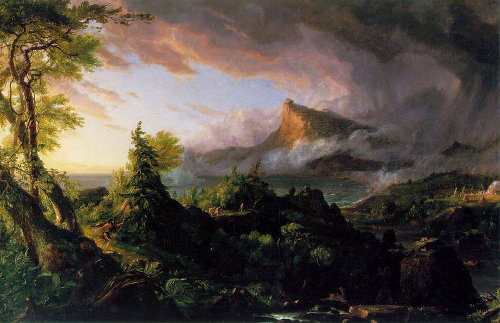 The Savage State. Nature in its wild, untamed state. People are low-tech; a tribal man hunts with bow and arrow. The great mysteries of nature are untrammeled and swirl about. The sun is rising on the day. Look closely and you’ll see wigwams and a campfire, the seeds of a city.
The Savage State. Nature in its wild, untamed state. People are low-tech; a tribal man hunts with bow and arrow. The great mysteries of nature are untrammeled and swirl about. The sun is rising on the day. Look closely and you’ll see wigwams and a campfire, the seeds of a city.
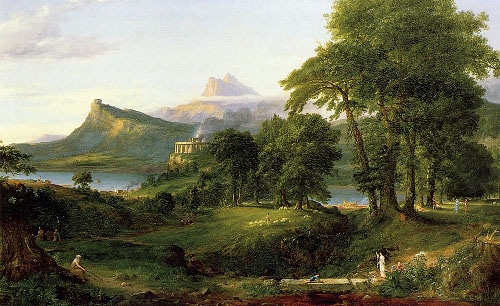 The Arcadian or Pastoral State. The skies have cleared and lightened, civilization has advanced. A temple has been erected. An old philosopher-looking man writes with a stick. In the distance, a man is plowing and women are dancing. The setting is idyllic. It’s a brilliant morning, and the people live in peace, happiness, and harmony with nature.
The Arcadian or Pastoral State. The skies have cleared and lightened, civilization has advanced. A temple has been erected. An old philosopher-looking man writes with a stick. In the distance, a man is plowing and women are dancing. The setting is idyllic. It’s a brilliant morning, and the people live in peace, happiness, and harmony with nature.
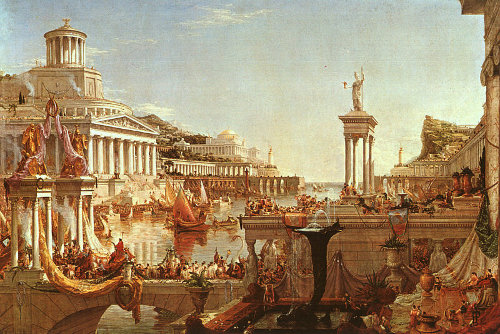 The Consummation of Empire. Civilization has reached its peak. The population has grown and erected great buildings and built great ships. It is late in the day. Besides the water and a hint of vegetation here and there, nature has disappeared and been completely covered over.
The Consummation of Empire. Civilization has reached its peak. The population has grown and erected great buildings and built great ships. It is late in the day. Besides the water and a hint of vegetation here and there, nature has disappeared and been completely covered over.
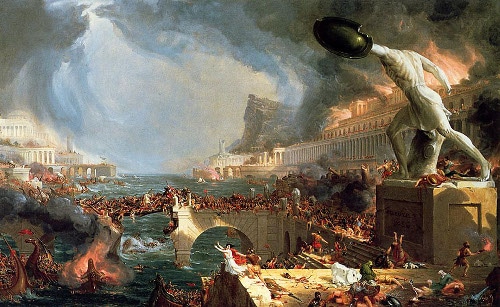 The Destruction. The civilization crumbles. While an enemy army attacks the city, a tempest rages. The great man-made monuments fall to pieces, the edifices ransacked, the people killed.
The Destruction. The civilization crumbles. While an enemy army attacks the city, a tempest rages. The great man-made monuments fall to pieces, the edifices ransacked, the people killed.
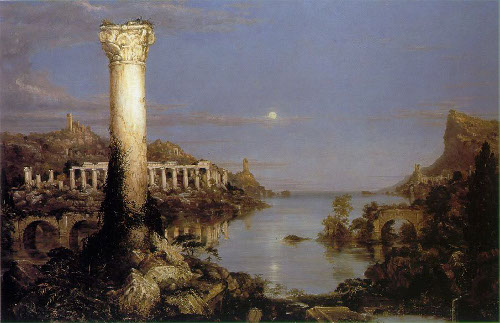 Desolation. The sun has set on this civilization. Humans are nowhere to be found. Nature has reclaimed the monuments of man. Sic transit gloria mundi.
Desolation. The sun has set on this civilization. Humans are nowhere to be found. Nature has reclaimed the monuments of man. Sic transit gloria mundi.
The Voyage of Life
Painted by Cole in 1840, the Voyage of Life series depicts four stages of a man’s life and serves as a Christian allegory set in a Romantic backdrop.
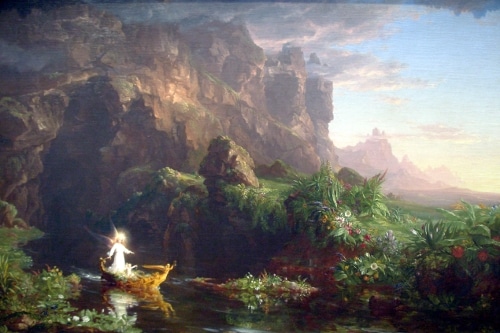
Childhood. The baby exits the dark canal and begins his new life. The water is calm and smooth, the surroundings innocent and Edenic. The boy’s guardian angel grasps the tiller and controls the boat.

Youth. The water is still smooth, the surroudings still peaceful and lush. But now the angel leaves the boy, who eagerly takes the tiller himself and sets off on his own towards his lofty dreams and ambitions. It is hard to tell from this image of the painting, but around the bend of the river the water begins to get choppy and rough; journeying to the castle of his dreams will not be as easy as it now seems.
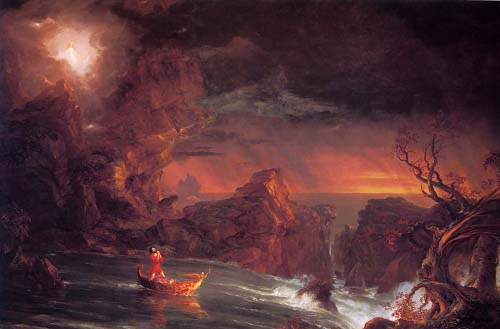
Manhood. The boy is now a man. The vegetation is gone; the waters are choppy; the skies have darkened. The tiller of the boat is gone; the man is no longer entirely in control, and he prays for help. The angel still watches over him, but now from afar. The man cannot see the angel and must have faith that she is there. Cole wanted to convey the way the dreams and idealism of youth crash into the “realities of the world.” The ocean symbolizes the end of the man’s life; he can begin to see it, and the warmth of the sunset hints of hope in the midst of his trials.
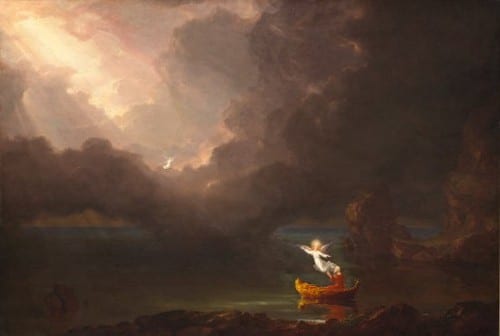
Old Age. The man is now old and the angel returns to his side. His boat has made it to the ocean. The waters are once more calm. The light is breaking through the dark clouds. The man’s faith has sustained him throughout the trials of life and now the beauty of eternity stretches out before him.
If you look at much larger images of these paintings, you can find more interesting bits of symbolism in each.
No art is meant to be seen as small images on a computer, but this is especially true of Romantic art. It was designed by the artists to convey grand, sweeping landscapes that expanded the spirit of man when viewed. So if there’s a museum in your town that has such paintings on display, be sure to go and visit.
The Basics of Art Series
The Renaissance
The Baroque Period
The Romantic Period


